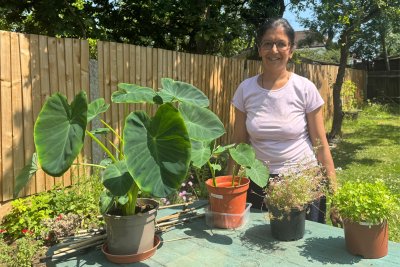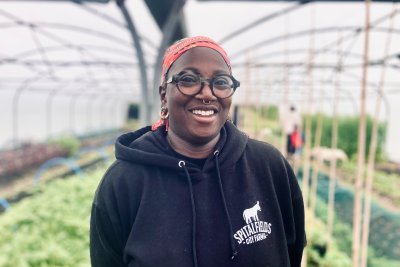.jpg) Spatial visions for food cities / Gillian Morgan
Spatial visions for food cities / Gillian Morgan
.jpg)
How can our food system benefit from planning reforms?
Government has published a package of proposals for reform of the whole planning system in England which could have a profound impact on food and farming. Gillian Morgan explores what is at risk, and where there might be opportunities from this consultation.
Planning policies and procedures already have a role to play in achieving a sustainable food system which reflects local character, meets community needs and results in healthy liveable communities[1]. Does it need a wholesale reform requiring new legislation or does it need the current system to be applied consistently and robustly?
The consultation asks curious questions such as:
- What three words do you associate most with the planning system in England? and
- What are your top three priorities for planning in your local area?
Surely, planning is about achieving well balanced, healthy, liveable communities with no one element taking priority over another, embracing and enabling the natural complexity of how and where we live. But again, the proposals aim to simplify things into threes, this time with types of land:
The White paper proposes simplified local plans. There will be three types of land: Growth areas suitable for substantial development; Renewal areas suitable for development; and areas that are Protected. All areas of land would be put into one of these three categories. Certain parameters will be set out in detailed policies either at national level or exceptionally in local plans. There will also be separate neighbourhood plans, masterplans and design codes spelling out the details. It is then anticipated that development or change of use that meets the requirements will be able to go ahead with a quicker and easier system of consent.
So what makes a planning system fit for purpose?
1 A process which gives communities an opportunity to describe their vision for the future of their place without having to run the consultation marathon against business interests and their planning barristers.
A simplified system could be open season for land exploitation and loss of public infrastructure. A simplified system accompanied by detailed criteria reflecting all aspects of a healthy community and the political will to make sure this is delivered on the ground would be the best of all.
Will this be an opportunity for communities to shape the place they live or a bonanza for planning lawyers to create new case law on behalf of landowners?
2 Political will and determination to ensure agreed plans, policies, masterplans and design codes are prepared and implemented.
All systems can be made to work where there is a will. Detailed policies for specific areas could already happen within the current planning system. But even when there are locally agreed policies in local plans, they are currently negotiated away by developers holding councils to ransom over development opportunities. How will a raft of new legislation ensure this does not happen?
Many councils have local plan policies that require development to incorporate space for food growing in landscaping schemes. These policies have been justified and supported by local food growers who can see the benefit this brings to residents and neighbourhoods. Bristol and Croydon local plans had such policies. But landscape plans for major residential planning applications routinely fail to identify the provision of communal food growing spaces. Indeed, conversations with planners reveals that such details get negotiated out of schemes both prior to approval and during development. Brighton and Hove City Council have detailed advice to accompany supportive planning policies on incorporating space for food growing in new development. However, increasing densities through piecemeal redevelopment means there is not enough land for on site provision.
3 Acceptance that the real world is a complicated place.
Categories of land uses develop through innovation and cannot be categorised, so planning policy needs to be flexible with safeguards.
Most of us do not live in such a picture book location where land can be classified into three broad categories (try it – get a map and 3 crayons). Has this idea been tested in a real place? How can you predict what new trends are on the horizon? How can an area that has developed over hundreds of years with a mosaic of land uses and landownership suddenly fall into 3 homogenous localities. Will there be room in the new planning system for the opportunities that arise from innovative ideas that lead to incremental change?
New entrants to the food business have innovated and pushed boundaries.[2] Often driven by the desire to connect food growers to consumers, farmers markets test the market by starting on vacant plots, under-used public spaces, empty car parks, school playgrounds. Pop up stalls run by residents’ coops in housing estates bring fresh food to people living in food deserts. We need a planning system which allows innovation.
Changes in consumer behaviour mean town centres also have to change. This is an opportunity for social renewal with a future for high streets as community hubs based on local food culture run by local people.[3] But small businesses, local suppliers, mutual aid groups find it challenging to participate in a planning system which favours companies represented by planning consultants and lawyers.
4 Core development principles are embedded into national development management polices
I would like to see more detail about how national development management policies would be agreed; how would the public be able to understand what it meant in their local area? The government should not be asking the nation to commit in advance of seeing the full implications at the local level.
Nevertheless, there is currently a policy gap at national & regional levels which a reformed planning system could fill. There are some planning policies that could be taken from nationally agreed strategies. These should not be left to local councils to re-justify through their local plan, especially when challenged by big business.
Councils’ hot food takeaway policies are routinely challenged by the big fast-food chains. In Nottingham, the planning inspector decided there was insufficient “locally specific evidence” to keep the policy. Why would the evidence be different in Nottingham? Are children’s bodies in some parts of the UK more resistant to diabetes and heart disease?[4]
KFC submitted 38 pages of reports and articles as their further evidence to the local plan examination, just as they had submitted for many other local plan examinations. This was a complete waste of time for all council officers, councillors, the planning inspectorate, health and good food campaigners who had participated at some stage in the preparation of that local plan but money well spent by the chain who had an open invitation to look for new sites in that city.
This is an example of where there should be a national development management policy that is backed up through agreed national strategies eg The Government’s Obesity Strategy[5] and PHE’s nationwide evidence.
5 The definition of good design includes access to good food.
The idea of a sustainable local food system for a new community incorporates everything from encouraging healthy eating and community food-growing, to thinking about the commercial opportunities for growing, processing and distributing food within and beyond the new community.[6]
Access to healthy food is as vital neighbourhood infrastructure as playgrounds and recycling bays, these must be written into national planning policies. The right to a decent kitchen with storage space and room to sit and eat should be in national design standards. Details on how community kitchens, food growing spaces and provision for food enterprise can be provided in a particular local area should be written into local design codes.
The Hull residential design guide[7] has many illustrations showing how their local policies can be interpreted on development sites to achieve investment and resilience towards a future for the city. For example, how, even on small sites, there are many opportunities to create spaces for planting and growing food in micro-allotments on balconies, by front doors or in shared spaces.
Local authorities should have more say over the provision of community infrastructure alongside development of housing and commercial spaces, and power to transform derelict spaces and vacant buildings for community benefit.
TCPA Practical Guide “Edible Garden Cities”[8] shows how the planning process can help to bring about sustainable local food systems in new communities. Case studies show that designing places which include sustainable local food systems can also help to create healthy and vibrant places. The multiple benefits include:
- improved health and wellbeing;
- inclusive and sociable communities;
- environmental restoration and sustainability, including resilience to climate change;
- opportunities for economic development, investment and skills development; and
- improved amenity and good urban design.
6 Rural and Periurban land is safeguarded for food growing
In the wake of the Covid-19 pandemic, more than ever, we must unlock land around cities to create a renewed model of peri-urban food production across the UK. In the face of the climate and nature emergency, soil degradation and loss of natural ecosystems, growers and campaigners have been looking at food system shifts. These would change how we value food and factor in the public goods that the best types of farming provide. Farmers and farming advocates have been pushing to get the recognition that agro-ecological and nature-friendly farming is a necessity. We know this can flourish on the edge of cities, shortening supply chains, bringing food closer to the people and building a better understanding of how our food is produced.[9]
The planning system should ensure long term certainty that land suitable for sustainable food growing will not be under a continual threat of development or be held for its “hope” value. This includes space for environmentally beneficial fruit and nut tree planting, community food and small farm enterprises, especially in horticulture. More fruit and vegetable production in the UK is needed given the vulnerability and sustainability of our current global supplies and because as a nation we are not eating enough for a healthy diet.
New entrants to farming are looking for land nearer to urban conurbations, that could provide the kinds of outdoor part-time jobs that many city dwellers crave.[10]
Sustain’s briefing on land use "A Green and Pressured Land - making sense of the many competing demands for rural and peri-urban land"[11] looks at the many pressures on land in the UK and our use of land overseas, including the impact of agriculture and the types of food consumed.
7 Local policies are prepared according to strict timescales
Participation in the drafting of any policy, masterplan or design code should be focussed and timely. Councils should be committed to keeping to published timescales so that communities and businesses alike know how to allocate their time. Local campaigners are always on the back foot. Planning policy is a distraction to their main function until they are confronted by a planning application which threatens the local food system. Major businesses have the resources to employ planning consultants to monitor the preparation of local plans across the country and prepare submissions on their behalf.
In recent years, Sustain has encouraged local food partnerships[12] to engage in their local planning system. We understand planning is not easy to influence without professional help. The food partnership in Hull was initially reluctant to get involved in their local plan for this reason of lack of capacity and expertise. They are running active projects to improve access to good food across their city. Having bravely attended a local planning consultation event, they were welcomed by the planners. They never imagined how long the process would take, even though they were pushing at an open door and wondered whether they should be investing such time.[13] One of the worst things can be the periods of silence in between each public consultation. This loss of momentum is difficult for voluntary organisations to keep engaged.
How might the new planning system support and balance these considerations?
Sustain will be reviewing the government’s proposals to assess how they will make it easier to achieve the considerations above. In short, we would want to see a planning system that:
- embeds core development principles into national development management polices
- reflects regional and local differences
- identifies land to be safeguarded for food production
- brings forward housing development with sufficient amenity green space for multiple purposes including community and private food growing
- provides all homes with internal space for food storage, preparation, and cooking, allowing the household to eat together when they wish
- ensures access to healthy food and avoids easy access to unhealthy food
- encourages local entrepreneurship in sustainable food industries
- achieves the above in a way that improves the environment and people’s wellbeing and
- facilitates the involvement of local people in shaping the place they live.
But whatever planning system we have, these challenges remain:
We are starting with places that already exist with current patterns of land ownership; local plans must manage and resolve the intricacies of change happening within the current framework of development.
Landowners want to achieve the highest value, so how will development that achieves public benefit be brought forward? Land comes up for development when the market is right for the landowner.
Planning helps achieve the right types of development in the right place, yet the planning system is opportunistic.
I would not dispute the ambition for new homes, thriving businesses, stewardship and improvement of natural resources and renewal and regeneration of villages towns and cities (“Planning for the Future” page 18). I question how best to achieve it and whether a new legislative framework is the way forward. Resources and political ambition should be focused on cutting through the barriers to operating the current system. I can see how the planning system can help achieve a sustainable food system, but there needs to be the will to make this happen.
The Government consultation on the planning proposals is open until 29 October.[14]
Planning Food Cities: Shaping the future of local areas to create a more sustainable and local food system.
Sustain
The Green House
244-254 Cambridge Heath Road
London E2 9DA
020 3559 6777
sustain@sustainweb.org
Sustain advocates food and agriculture policies and practices that enhance the health and welfare of people and animals, improve the working and living environment, promote equity and enrich society and culture.
© Sustain 2025
Registered charity (no. 1018643)
Data privacy & cookies
Icons by Icons8







